Classification, Morphology, Anatomy, Digestive system, Respiratory System, Circulatory system, Nervous System, Excretory System, Reproductive System, Economic importance of Frog - Common Indian Green Frog - Rana hexadactyla | 11th Zoology : Chapter 4 : Organ and Organ Systems in Animals
Chapter: 11th Zoology : Chapter 4 : Organ and Organ Systems in Animals
Common Indian Green Frog - Rana hexadactyla
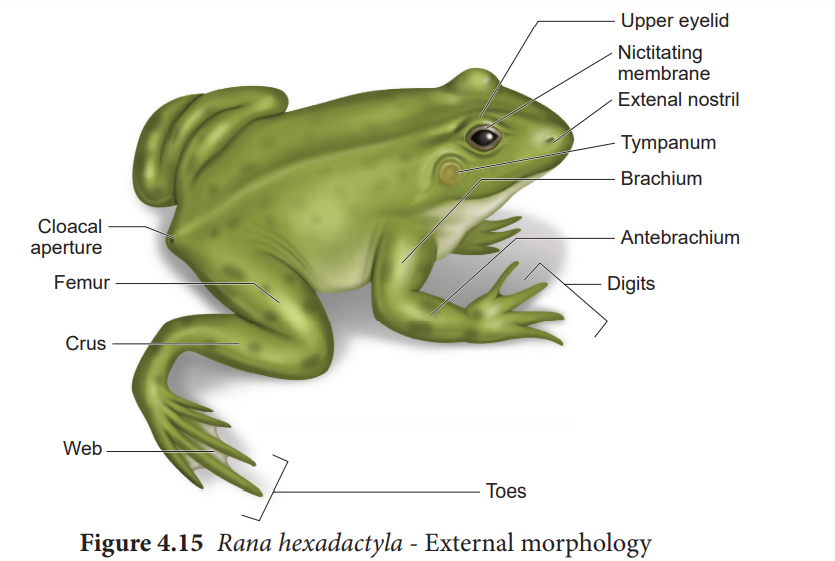
The Common
Indian Green Frog - Rana hexadactyla
About 360
million years ago, amphibians were the first vertebrates to live on land.
Amphibians are diverse, widespread, and abundant group since the early
diversification. There are about 4,500 species of amphibians. Frog is an
amphibian and hence placed in the class Amphibia [Greek. Amphi - Both, bios –
life]. The largest order, with more than 3,900 species, is Anura, which includes
the frogs and toads. Rana hexadactyla is
placed in the order Anura. Frogs live in fresh water ponds, streams and in moist places. They feed on small animals like
insects, worms, small fishes, slugs, snails, etc. During its early development
a frog is fully aquatic and breathes like a fish with gills. It is poikilothermic, i.e., their body temperature varies with the varying
environmental temperature.
Classification
Phylum : Chordata
Class : Amphibia
Order : Anura
Genus : Rana
Species : hexadactyla
Morphology of Frog
The body
of a frog is streamlined to help in
swimming. It is dorso-ventrally flattened and is divisible into head and trunk.
Body is covered by a smooth, slimy skin loosely attached to the body wall. The
skin is dark green on the dorsal side
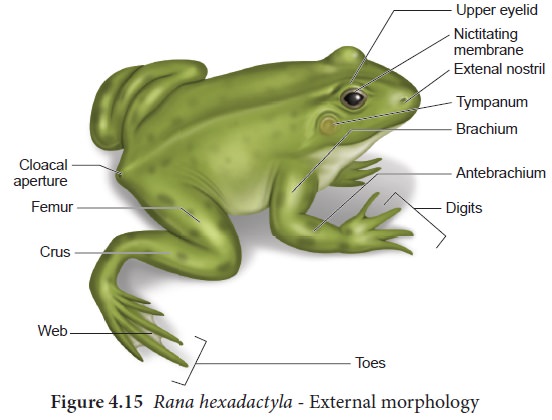
and pale
ventrally. The head is almost triangular in shape and has an apex which forms
the snout. The mouth is at the anterior end and can open widely. External
nostrils are present on the dorsal surface of the snout, one on each side of
the median line (Figure 4.15). Eyes are large and project above the general
surface of the body. They lie behind the external nostrils and are protected by
a thin movable lower eyelid, thick immovable upper eyelid and a third transparent
eyelid called nictitating membrane. This membrane protects
the eye when the frog is under water. A pair of tympanic membranes forms the ear drum behind the eyes on either
side. Frogs have no external ears,
neck and tail are absent. Trunk bears a pair of fore limbs and a pair of hind
limbs. At the posterior end of the dorsal side, between the hind limbs is the
cloacal aperature. This is the common opening for the digestive, excretory and
reproductive systems.
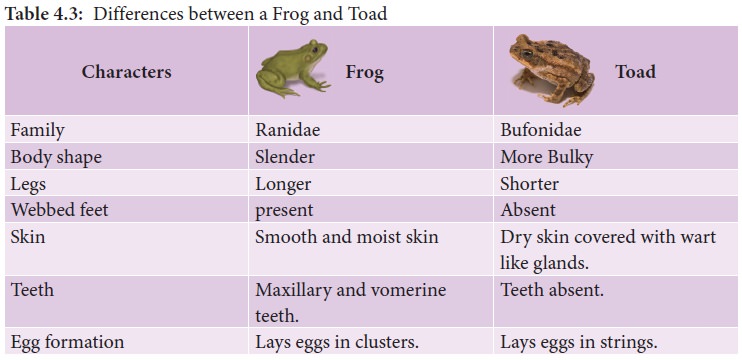
Fore limbs are short, stumpy, and helps to bear the weight of the body. They are also helpful for the landing of the frog after leaping. Each forelimb consists of an upper arm, fore arm and a hand. Hand bears four digits.
Hind limbs are large, long and consist of thigh, shank and foot. Foot bears five long webbed toes and one small spot called the sixth toe. These are adaptations for leaping and swimming. When the animal is at rest, the hind limbs are kept folded in the form of letter ‘Z’ . Sexual dimorphism is exhibited clearly during the breeding season. The male frog has a pair of vocal sacs and a copulatory or nuptial pad on the ventral side of the first digit of each forelimb (Figure- 4.16). Vocal sacs assist in amplifying the croaking sound of frog. Vocal sacs and nuptial pads are absent in the -female frogs.
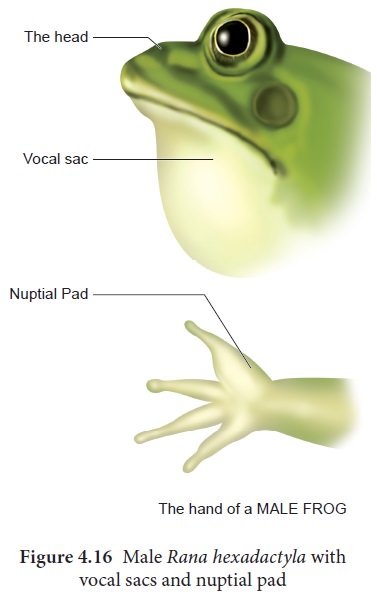
Anatomy
The Digestive System
The alimentary canal consists of the buccal
cavity, pharynx, oesophagus, duodenum, ileum and the rectum which leads to the
cloaca and opens outside by the cloacal aperture. The wide mouth opens into the
buccal cavity. On the floor of the buccal
cavity lies a large muscular sticky tongue. The tongue is
attached in front and free behind.
The free edge is forked. When the frog sights an insect it flicks out its tongue
and the insect gets glued to the sticky tongue. The tongue is immediately
withdrawn and the mouth closes. A row of small and pointed maxillary teeth is found on the inner region of the upper jaw
(Figure. 4.17) In addition vomerine
teeth are also present as two groups, one on each side of the internal
nostrils. The lower jaw is devoid of teeth. The mouth opens into the buccal
cavity that leads to the oesophagus
through the pharynx. Oesophagus is a
short tube that opens into the stomach and continues as the intestine, rectum
and finally opens outside by the cloaca
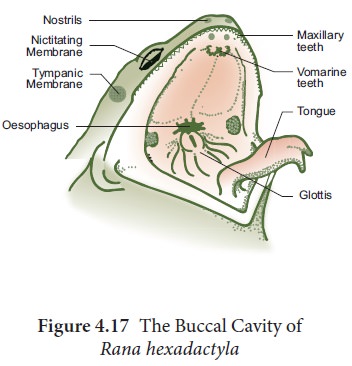
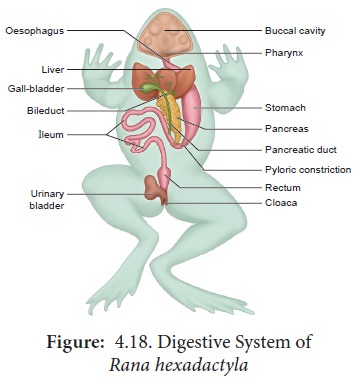
Liver secretes bile which is
stored in the gall bladder. Pancreas,
a digestive gland produces pancreatic juice containing digestive enzymes.
Food is
captured by the bilobed tongue. Digestion of food takes place by the action of Hydrochloric acid and gastric juices secreted from the walls
of the stomach. Partially digested
food called chyme is passed from the stomach to the first part of the
intestine, the duodenum. The duodenum receives bile from the gall bladder and
pancreatic juices from the pancreas through a common bile duct. Bile emulsifies fat and pancreatic juices digest carbohydrates,
proteins and lipids. Final digestion takes place in the intestine. Digested
food is absorbed by the numerous finger-like folds in the inner wall of intestine called villi and microvilli.
The undigested solid waste moves into the rectum
and passes out through the cloaca.
Respiratory System
Frog
respires on land and in the water by two different methods. In water, skin acts
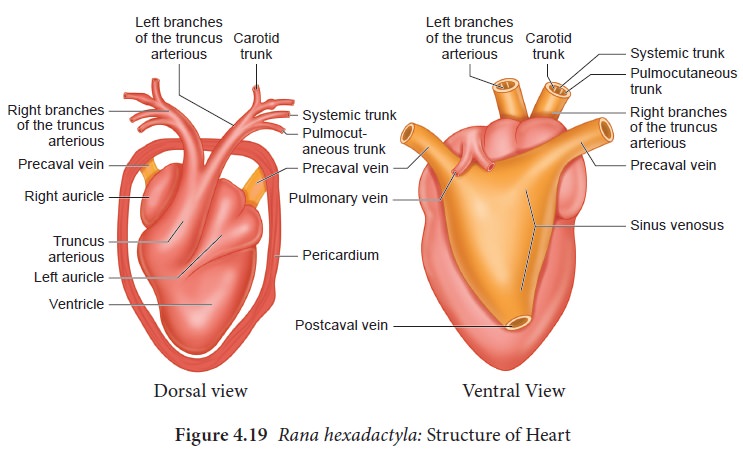
Dissolved oxygen in the water gets, exchanged through the
skin by diffusion. On land, the buccal cavity, skin and lungs act as the
respiratory organs. In buccal
respiration on land, the mouth remains permanently closed while the
nostrils remain open. The floor of the buccal cavity is alternately raised and
lowered, so air is drawn into and expelled out of the buccal cavity repeatedly
through the open nostrils. Respiration by lungs is called pulmonary respiration.
The lungs are a pair of elongated, pink coloured sac-like structures present in the upper part of the trunk
region (thorax). Air enters through the nostrils into the buccal cavity and
then to the lungs. During aestivation
and hibernation gaseous exchange
takes place through skin.
The Blood-Vascular System
Blood
vascular system consists of a heart with three chambers, blood vessels and
blood. Heart is covered by a double-walled membrane called pericardium. There
are two thin walled anterior chambers called auricles (Atria) and a single
thick walled posterior chamber called ventricle. Sinus venosus is a large, thin
walled, triangular chamber, which is present on the dorsal side of the heart.
Truncus arteriosus is a thick walled and cylindrical structure which is
obliquely placed on the ventral surface of the heart. It arises from the
ventricle and divides into right and left aortic trunk, which is further
divided into three aortic arches namely carotid, systemic and pulmo-cutaneous.
The Carotid trunk supplies blood to the anterior region of the body. The
Systemic trunk of each side is joined posteriorly to form the dorsal aorta.
They supply blood to the posterior part of the body. Pulmo-cutaneous trunk
supplies blood to the lungs and skin. Sinus venosus receives the deoxygenated
blood from the body parts by two anterior precaval veins and one post caval
vein. It delivers the blood to the right auricle; at the same time left auricle
receives oxygenated blood through the pulmonary vein. Renal portal and hepatic
portal systems are seen in frog (Figure. 4.19 and 420).

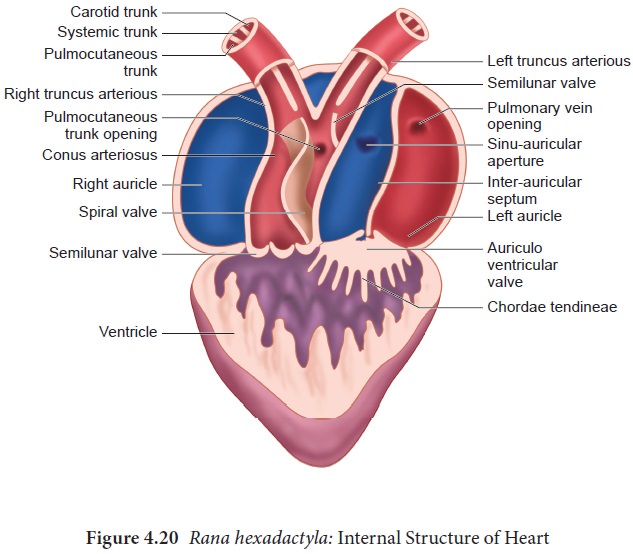
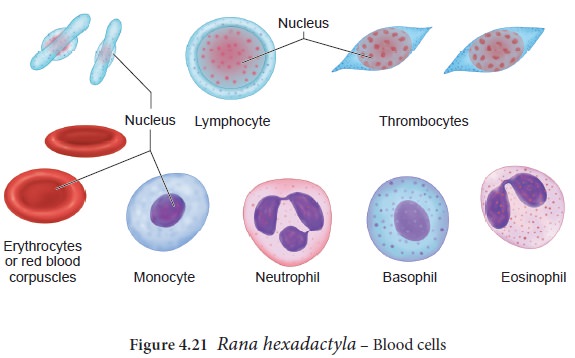
The blood consists of plasma [60%] and blood cells
[40 %], red blood cells, white blood cells, and platelets. RBCs are loaded with
red pigment, nucleated and oval in shape. Leucocytes are nucleated, and
circular in shape (Figure 4.21).
The Nervous System
The Nervous system is divided into the Central Nervous System [CNS], the Peripheral Nervous System [PNS], and the Autonomous Nervous System [ANS]. Peripheral Nervous System consists of 10 pairs of cranial nerves and 10 pairs of spinal nerves. Autonomic Nervous System is divided into sympathetic and parasympathetic nervous system. They control involuntary functions of visceral organs. CNS consists of the Brain and Spinal cord. Brain is situated in the cranial cavity and covered by two meninges called piamater and duramater. The brain is divided into forebrain, midbrain and hindbrain. Fore brain (Prosencephalon) is the anterior most and largest part consisting of a pair of olfactory lobes and cerebral hemisphere (as Telencephalon) and a diencephalon. Anterior part of the olfactory lobes is narrow and free but is fused posteriorly. The olfactory lobes contain a small cavity called olfactory ventricle.
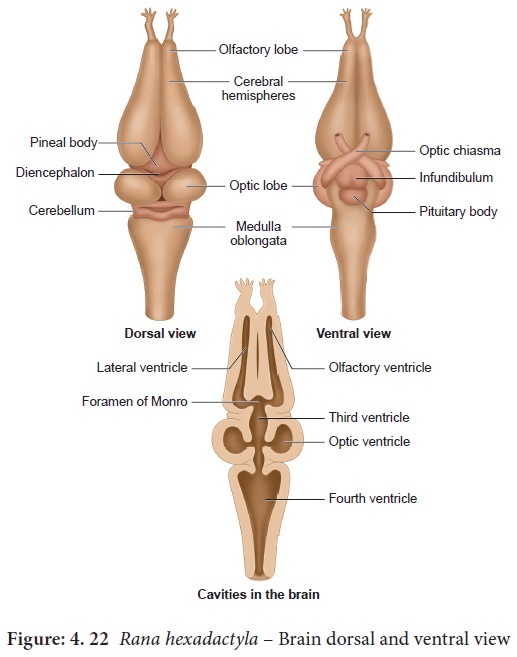
The mid brain (Mesencephalon) includes two large, oval optic lobes and has cavities called optic ventricles. The hind brain (Rhombencephalon) consists of the cerebellum and medulla oblongata. Cerebellum is a narrow, thin transverse band
followed by medulla oblongata. The
medulla oblongata passes out through the foramen
magnum and continues as spinal cord, which is enclosed in the
vertebral column (Figure 4.22).
Excretory system
Elimination
of nitrogenous waste and salt and
water balance are performed by a well developed excretory system. It consists
of a pair of kidneys, ureters, urinary bladder and cloaca. Kidneys are dark red,
long, flat organs situated on either sides of the vertebral column in the body
cavity. Kidneys are Mesonephric.
Several nephrons are found in each kidney. They separate nitrogenous waste from
the blood and excrete urea, so frogs are called ureotelic organisms. A pair of ureters emerges from the kidneys
Reproductive system
The male frog has a pair of testes which
are attached to the kidney and the dorsal body wall by folds of peritonium
called mesorchium. Vasa efferentia arise from each testis. They enter the kidneys on both side and open into the
bladder canal. Finally, it communicates with the urinogenital
duct that comes out of kidneys and opens into the cloaca (Figure 4.23).
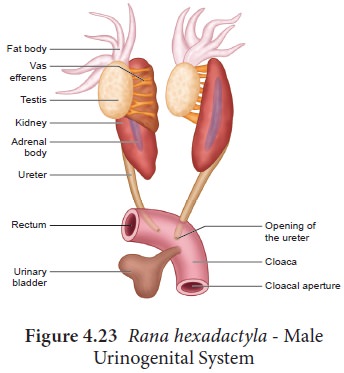
Female reproductive system -(Figure
4.24) consists of paired ovaries, attached
to the kidneys, and dorsal body wall
by folds of peritoneum called mesovarium. There is a pair of coiled oviducts lying on the sides of the
kidney. Each oviduct opens into the body-cavity at the anterior end by a funnel
like opening called ostia. Unlike the male frog, the female frog has separate
genital ducts distinct from ureters. Posteriorly the oviducts dilated to form ovisacs before they open into cloaca.
Ovisacs store the eggs temporarily before they are sent out through the cloaca.
Fertilization is external.

Within
few days of fertilization, the eggs
hatch into tadpoles. A newly hatched
tadpole lives off the yolk stored in its body. It gradually grows larger and
develops three pairs of gills. The tadpole grows and metamorphosis into an air – breathing carnivorous adult frog
(Figure 4.25). Legs grow from the body, and the tail and gills disappear. The
mouth broadens, developing teeth and jaws, and the lungs become functional.
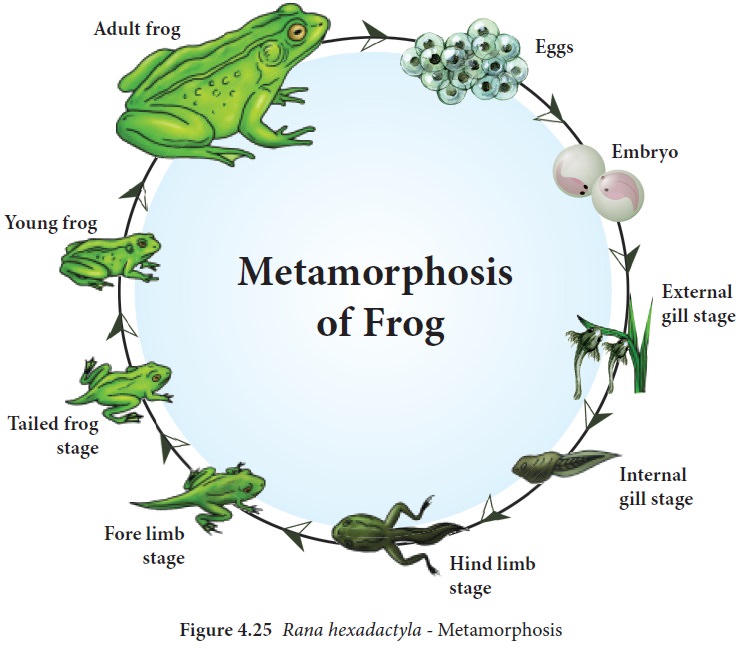
![]()
Economic importance of Frog
•
Frog is an important animal in the food chain; it helps to maintain our
ecosystem. So ‘frogs should be
protected’.
•
Frog are beneficial to man, since they feed on
insects and helps in reducing insect pest population.
•
Frogs are used in traditional medicine for
controlling blood pressure and for
its anti aging properties.
•
In USA, Japan, China and North East of India, frogs
are consumed as delicious food as
they have high nutritive value.
Related Topics